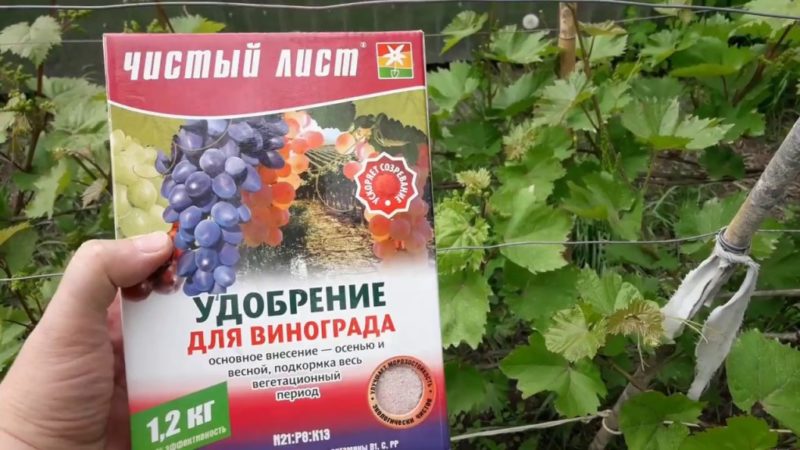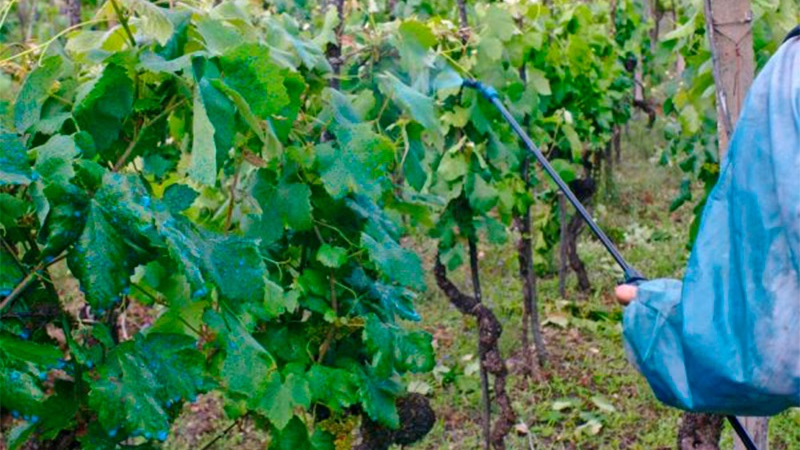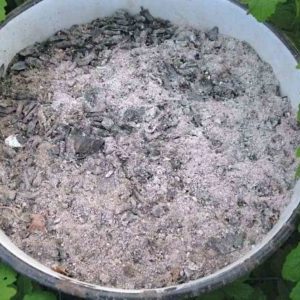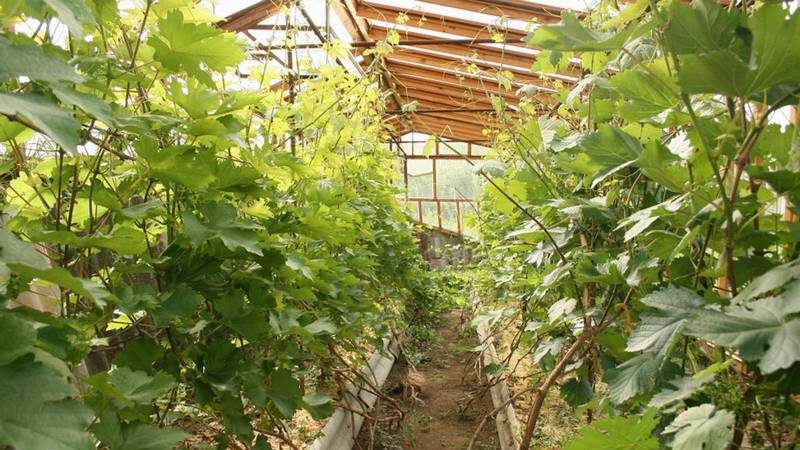How and what to feed grapes in July in the Middle Lane
Grapes are picky about growing conditions. In order for the shrub to grow well in any climate and regularly bear tasty fruits, it is fed. Gardeners use organic, mineral and folk fertilizers, depending on the condition and age of the bush. Consider how to feed grapes for a good harvest and what recommendations of experienced winegrowers to follow.
The content of the article
What dressings do grapes need in July in the middle lane

Top dressing is a source of micro- and macroelements that grapes need for long and healthy fruiting... If you do not fertilize the plants, they grow sluggish and low-yielding, especially in the conditions of central Russia.
The climate in these regions is changeable, the lands are not fertile, so the grapes need organic, mineral and complex fertilizers.
Substance deficiency symptoms

In July gardeners reduce the amount of nitrogen-containing dressings and increase the introduction of potassium-phosphorus. With a lack of potassium, the water balance is disturbed - part of the water obtained from irrigation is wasted. Also, the resistance of the culture to fungal diseases and frost decreases, the plant is more susceptible to the influence of external factors.
It is easy to recognize a lack of potassium: the lower leaves of the shrub turn purple, then turn brown and die off. If measures are not taken in time, the bush slowly fades, the fruits that are set fall off. Potassium deficiency is especially common in soils with a high lime content.
Another common problem is phosphorus deficiency. The growth and development of the root system slows down, the shrubs slowly wither away. Withering begins with a change in the color of the leaves - they become pale, brown streaks appear on some. Later, the petioles are actively lengthened, the leaf plates are twisted upward. Sometimes the leaves become covered with red spots, which become larger over time. This is how necrosis begins - the death of leaf plates.
Attention! In addition to potassium and phosphorus in July, the vineyard needs zinc, boron and magnesium. Zinc deficiency is recognized by yellow and dry leaves, boron deficiency - by light leaves and shedding of flowers. If the grapes lack magnesium, the shoots stop growing, become dry and brittle. Sometimes the plant lacks several trace elements at once, in this case it is required to fertilize it with a complex top dressing.
Terms of top dressing in July
In July, the grapes are fertilized while the fruit is being poured. In the Moscow region and the Moscow region this is the middle of the month, in the Rostov region and other southern regions - the beginning, in the Urals and Siberia - the end.
There are no specific dates, it is recommended to rely on climatic conditions. Favorable days - when the weather is dry and calm, there is no rain or wind. The optimal time of day for the procedure is early morning, while there is no sun.
Some summer residents choose the day of fertilization in accordance with the lunar calendar. In 2020, they are suitable for mineral dressings on July 24-30, for organic ones - 1-3, 9-11. Unfavorable days according to the lunar calendar - July 15-17.
How to feed grapes in July in the middle lane
Both organic and mineral fertilizers positively influence the development of grapes and yield.The main thing when preparing them is to observe the recommended dosages and safety measures.
Organic feed
 Organics strengthens roots and improves soil composition. Summer residents use humus - scatter it around the bush, having previously loosened the ground.
Organics strengthens roots and improves soil composition. Summer residents use humus - scatter it around the bush, having previously loosened the ground.
After applying humus, the soil becomes light and breathable, more oxygen enters the roots.
Before using the humus, it is important to make sure that it does not contain pest larvae. It is also recommended to water the vineyard abundantly before the procedure to reduce the risk of root burns. Humus is introduced once every 2-3 years.
Wood furnace ash is needed in July - a source of potassium, boron, copper and zinc. It reduces the acidity of the soil, makes it more nutritious. A groove 10 cm deep is made around the trunk, ash is poured into it, and soil is sprinkled on top. Top dressing is used annually. Ash can also be mixed with compost applied under the bush.
Mineral fertilizers
Mineral fertilizers are convenient because they are suitable for any soil... They are versatile, sold in garden stores, and easy to prepare. In July, the vineyard will be helped by fertilizing with potassium nitrate. 10 liters of room temperature water are poured into a clean plastic bucket and 150 g of potassium nitrate are poured. Stir, then bring under the bush. Consumption rate - 2 liters per plant. Top dressing with potassium nitrate stimulates the ripening of fruits, improves their presentation, strengthens immunity to diseases and pests.
Mineral complex dressings are also in demand, for example, the compositions "Aminosol" and "MicroMix". The first contains amino acids, protects the plant from stress and increases yields. In 1 l of water, dilute 5 ml of the drug and add to the root. "MicroMix" increases plant immunity to diseases, does not contain chlorine and heavy metals. In 10 liters of water, 20 mg of the drug is added, used for spraying or watering.
Attention! When preparing working solutions, the dosages indicated on the packaging by the manufacturer are observed. Otherwise, the grapes will receive salt shock or chemical burns. Store ready-made solutions for no more than 12 hours.
Folk remedies

Folk remedies attract gardeners with low cost and efficiency. Universal dressing for grapes - onion peel solution. 20 g are soaked in 5 liters of boiling water and infused for 5 days.
The resulting concentrate is diluted with pure water in a ratio of 1: 2. Use a solution for watering the bushes. The product protects against diseases and insects. For effectiveness, 100 g of dry grated soap is added to it.
Indispensable in the garden and nettle solution. The herb contains 34% potassium, 37% calcium, 6% magnesium, as well as organic acids and vitamins A and E.
The branches and leaves of the nettle are poured into the barrel so that they take up half of the container. Pour boiling water over the grass and leave for 2 weeks, stirring daily. Fermentation will begin, the infusion will darken. After 2 weeks, it is diluted with water in a ratio of 1:10 and used for irrigation. Summer residents are advised to prepare the product in a wooden or plastic barrel. Metal is not suitable - due to a reaction with metal, the herb will lose its beneficial properties.
How to properly feed
The effectiveness of fertilizers also depends on the correct application. There are two ways - root and foliar... The first is aimed at feeding the grapes from the soil, the second - from the leaves. Summer residents are advised to alternate these methods with each other.
Root way
Before applying organic or mineral fertilizing, the soil is preliminarily loosened with a rake to a depth of 5-7 cm. This will help the nutrients to be absorbed faster. Also, the grapes are pre-watered, no top dressing is applied to dry ground. A moist environment encourages more trace elements to reach the roots. Water also protects the grapes from burns.
If dry fertilizers are used, they are evenly scattered around the bush, and then buried to a digging depth.If solutions are used, grooves with a depth of 10 cm are first prepared around the bush.After the fertilizer has been absorbed, they are sprinkled with dry earth.
Foliar method
The solution should stay on the leaves as long as possible, so summer residents spray the grapes in the early morning or evening... Spray fertilizer on the outside and inside of the leaves. Spray the plant until the solution starts dripping from the foliage.
It is recommended to combine foliar feeding with other agrotechnical measures: watering, preventive treatment against diseases and pests, formation. The advantage of the foliar method is that it can be used throughout July. It is important to remember that the last treatment is carried out no later than 3 weeks before harvest.
It is interesting:
What grape care is required in June and how to properly carry it out
Top dressing during flowering / fruiting
Flowering in July occurs in a number of late-ripening varieties, for example, in the grapes Karaburnu or Donskoy white. At this time, it is recommended to pay attention to complex fertilizers. Summer residents use the drug "Humate +7 IOD". Fertilizer based on humic acids stimulates flowering and fruit set, increases productivity, improves soil fertility. In 10 liters of water, dilute 2 g of the drug, water the grapes at the root at the rate of 2 liters per bush.
Attention! A week after the procedure, the plants are sprayed with nettle infusion. An integrated approach guarantees strong plant immunity and good yields.
During fruiting, the plantings are fertilized with iron chelate. It completely dissolves in water, is quickly absorbed by the plant, and is combined with other dressings. In 10 liters of water, 5 g of iron chelate are diluted and the vineyard is sprayed twice a week. The solution not only increases yields, but also protects against a common disease - chlorosis.
Tips from experienced winegrowers

The advice of experienced winegrowers helps to grow a sweet and juicy harvest on your garden plot. They recommend:
- apply fertilizers in dissolved form;
- when choosing the date for feeding, pay attention to the weather conditions;
- dilute fertilizers in more water so that they are evenly distributed;
- prepare solutions immediately before use, do not store them;
- apply liquid organic matter after rain;
- if the plant is sick, use foliar fertilizers;
- alternate organic and mineral compositions.
Conclusion
In July, summer residents focus on phosphorus-potassium fertilizers. Ash, nettle infusion, potassium nitrate are introduced under the bushes. Fertilizers stimulate fruiting, protect grapes from cracking and frost, and increase the resistance of the crop to diseases.
Growers are advised to apply fertilizers in liquid form - this way they are better absorbed. Together with the root, foliar dressings are used - they spray the bushes with complex or folk remedies. The interval between procedures should be at least 3 weeks. Otherwise, the plant suffers from an excess of nutrients.